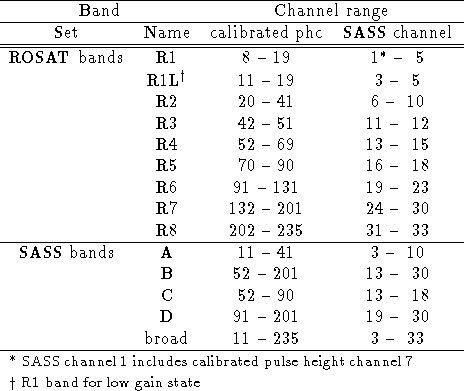




Next: 6.6 Products of the
Up: Spectral Analysis
Previous: Output key words
As already mentioned in the overview of this chapter
all instrumental dependences are well separated in
standardized and extentable modules.
Most of them are described in
chapter 4.
Some of these modules might only be relevant for a
specific instrument, some even might be not present
or a specific feature is lost.
A spectral analysis e.g.cannot be performed
if a photon counter has no spectral resolution.
But if such a counter has a well defined energy
acceptance (e.g.filter),
its signal can be used in connection with other
similar detectors to combine the whole information
to a spectrum.
Spectra taken at the same time with different instruments
can be fitted simultaneously.
Details can be found under
section 6.2
Since the position sensitive proportional counter (PSPC)
-- a major part of the focal plane
instrumentation of the ROSAT X-ray telescope (XRT) --
plays a special role in the context of the spectral analysis
of EXSAS some of its properties are listed:
- Its energy acceptance in connection with the XRT ranges
approximately from .1 keV to 2.4 keV.
- Its energy resolution behaves as

This means, that the detector has an energy resolution (FWHM)
of 40 pulse height channels at 1 keV or roughly five to six
independent energy bands. This fact always has to be considered
when fitting a spectrum. Even if the spectrum contains  counts it does not make sense to stay with all pulse height
channels of the PSPC. Depending on the statistics in most cases
a spectrum of 30-40 bins will be sufficient.
counts it does not make sense to stay with all pulse height
channels of the PSPC. Depending on the statistics in most cases
a spectrum of 30-40 bins will be sufficient.
- Its particle background rate is expected to be in the order of
10  counts s
counts s  arcmin
arcmin  ,
but will vary with geomagnetic latitude.
A rejection efficiency of this background
was measured up to 99.5%.
,
but will vary with geomagnetic latitude.
A rejection efficiency of this background
was measured up to 99.5%.
- Its detection efficiency depends very strong on its energy
mainly because the incoming X-ray photon has to penetrate
the PSPC entrance window.
Up to the carbon edge at .28 keV this efficiency is about
50%, drops after that suddenly to zero and increases
then continuously up to 70%.
- Its response function is normalized to 1
and up to now compressed to a
 matrix with
256 pulse height channels and
729 energy positions,
at which the mirror reflectivity is known.
But be aware - these dimensions may change with time.
matrix with
256 pulse height channels and
729 energy positions,
at which the mirror reflectivity is known.
But be aware - these dimensions may change with time.
- The current matrix is defined only between pulse height
channel 8 and 250 (inclusive boundaries). Therefore, a PSPC
spectrum should be used only between these channels.
- The following linear energy-channel relation is used
(only for plotting purpose):

The energy value of each channel can be taken from the
descriptor ENERGY_OF_CHANNEL of the detector
response matrix
(see section 6.4.2).
- The calibrated amplitudes as given in the photon events files
(label AMPL) are already corrected for possible gain shifts
of the detector.
That means that all changes in the PSPC detector response
matrix up to now are only improvements according to better
understanding.
- In the meantime two sets of standard pulse height channel (energy)
bands have been defined, the so called ROSAT and SASS bands.
The eight ROSAT bands (channels refer always to the calibrated
pulse height amplitude according to label AMPL) are used
for different instrument maps.
From these basic ROSAT bands five SASS bands
A, B, C, D, and broad are derived.
The exact definition of these bands can be found in
Table 6.11.
The two hardness ratios HR  and HR
and HR  defined in
section 6.6
(see also subsection 4.1.6)
are deduced from these SASS bands.
defined in
section 6.6
(see also subsection 4.1.6)
are deduced from these SASS bands.

Table 6.11:
Definition of the PSPC pulse height channel bands





Next: 6.6 Products of the
Up: Spectral Analysis
Previous: Output key words
If you have problems/suggestions please send mail to
rosat_svc@mpe-garching.mpg.de

![]() counts it does not make sense to stay with all pulse height
channels of the PSPC. Depending on the statistics in most cases
a spectrum of 30-40 bins will be sufficient.
counts it does not make sense to stay with all pulse height
channels of the PSPC. Depending on the statistics in most cases
a spectrum of 30-40 bins will be sufficient.
![]() counts s
counts s ![]() arcmin
arcmin ![]() ,
but will vary with geomagnetic latitude.
A rejection efficiency of this background
was measured up to 99.5%.
,
but will vary with geomagnetic latitude.
A rejection efficiency of this background
was measured up to 99.5%.
![]()
![]() and HR
and HR ![]() defined in
section 6.6
(see also subsection 4.1.6)
are deduced from these SASS bands.
defined in
section 6.6
(see also subsection 4.1.6)
are deduced from these SASS bands.
